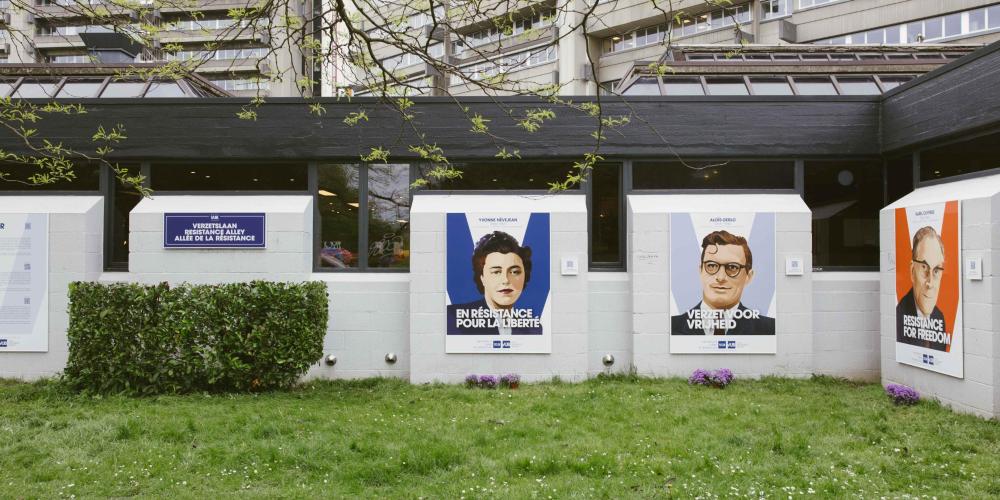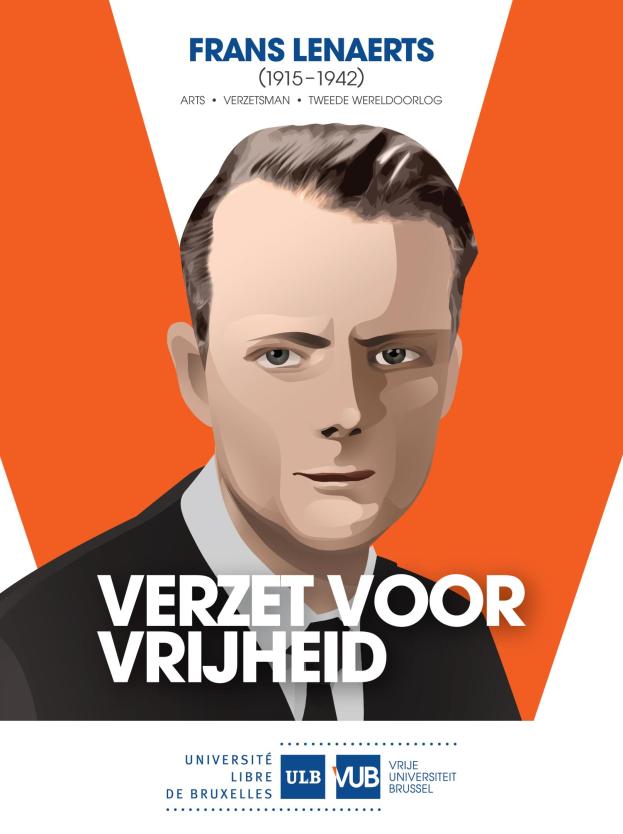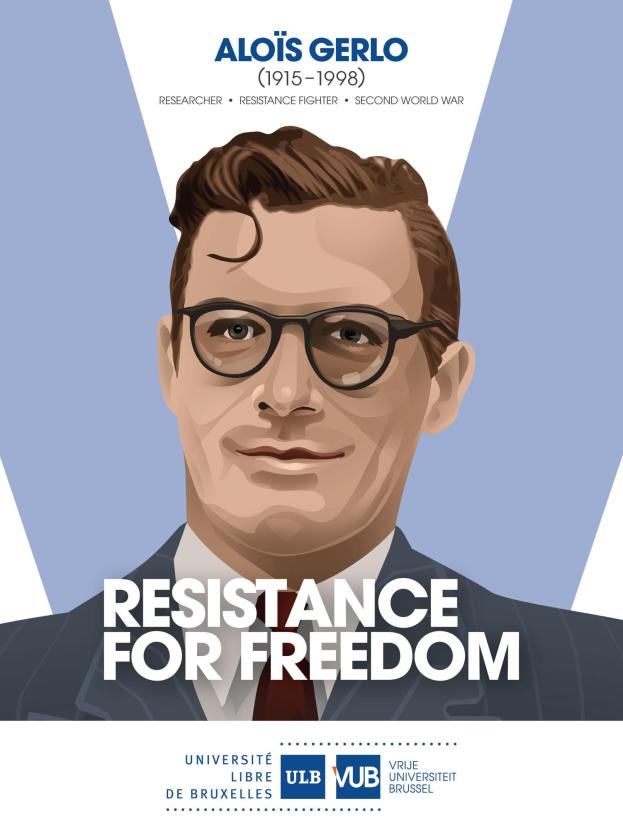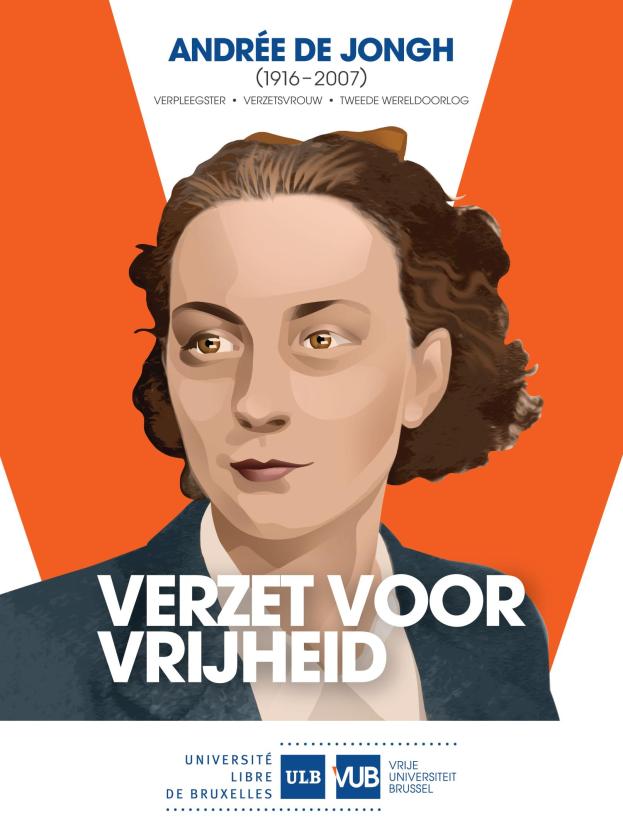
The VUB opened a resistance trail on its Etterbeek campus to mark the commemoration of resistance fighters on Wednesday 8 May. Along the trail hang portraits of members of the resistance. CAVA, the archive of the VUB and liberalism, was responsible for the biography of three of these resistance fighters who have a link to the VUB. The VUB did not yet exist in World War II; it emerged from ULB and was founded in 1970. CAVA coordinator Rik Röttger: “Many resistance fighters were the same age as our students are today.”
What is the importance of commemorating the resistance?
Rik Röttger: “The resistance fighters you meet on the path all tell their own story. You see that they each entered the resistance based on their own background and motivations, and that it was not always a conscious choice; sometimes it just happened to them. We want to show that the past also has meaning for the present. That resistance does not always have to be armed, but it is not impossible either. After all, it happened in the past. Fascism was overcome at the time. Humanity has already proved that very, very evil things can happen. Resistance in small steps is always possible. It would be nice to think about that now.”

Who will be honoured with a portrait on campus?
“We created a biography from the archives of three resistance fighters who have a clear link to ULB/VUB. The first is Frans Lenaerts, a doctor who did his specialisation at ULB. Then we have the first rector of the VUB, Aloïs Gerlo. And finally, Karel Cuypers, who had a minor assignment as professor of astronomy at the VUB and was one of the founders of the Humanist Alliance. Other resistance heroes are also given a place on the trail.”
What acts of resistance did they commit?
“Frans Lenaerts lived in Schaarbeek, not far from the station. He began noting all the transports and troop movements that took place on the railroad. That information was then smuggled to England through a network that already existed in World War I.
“We also discovered that he was in an armed group whose meaning and actions aren’t clear. Perhaps that organisation was also very young. They were all young people, weren’t they, in their early 20s, people just starting university. Some were younger, 17 or 18. Many resistance fighters were the same age as our students are today.
“His life ends at a young age. There are different versions. According to biographical notes, he was on a punitive expedition to apprehend traitors when their truck was stopped by a German patrol. Another source claims he was involved in a firefight after they threw the corpse of an informer into the canal near Saincteletteplein. In any case, Lenaerts was executed by the Germans on 17 December 1943.
“Former rector Aloïs Gerlo was active in the clandestine press. He studied classical languages in Ghent and slowly but surely became part of the resistance. He wrote articles, but mainly sought collaborators to write pieces. There was not much media, and people yearned for hopeful news to make them feel that it was not yet lost. The underground press was very important. They were stencilled pages that were passed around. Gerlo tried to connect those different little magazines and exchange news, creating a kind of press agency of the resistance. This wasn’t without danger, as he was arrested a few times. The story goes that at one point he thought he would be arrested at the Royal Library, which he had access to as a scientist. He was then said to have eaten the papers containing resistance information while in the toilet. Eventually, he worked his way up to become deputy secretary of the Independence Front. After the war, he sat as a representative of the independent resistance on all sorts of committees that recognised resistance fighters’ actions.

“Karel Cuypers I always call the teacher. He was principal of the Rijksatheneum in Hoboken and was a very good, quiet man. No one ever knew he was in the resistance. Like Gerlo, he did not engage in armed resistance. He was a member of the Teachers’ Union of Official Secondary Education. This consisted of people from the Athenea Stadscholen in Antwerp. Mostly they had a liberal background and were very anti-fascist, as well as intellectual. Their main concern was to protect their students from, for example, compulsory employment. They made sure that student lists did not get into the hands of the Germans, also because there might be Jewish children in those schools. They didn’t want those young people to be discovered and deported.”
What were their motivations for joining the resistance?
“That’s a difficult one to answer. That’s why we are happy to work with VUB professor Nel De Mûelenaere on the Traces of the Resistance research chair to gain more insight. There can be different motives behind the resistance. Take Frans Lenaerts, for example. He was a student in a movement in Ghent of which a number of boys had gone to the Spanish Civil War. There were three to six of them, but in a circle of friends that’s a lot. So there was already a kind of foreshadowing of anti-fascist resistance in that group. Lenaerts had seen that, and when the moment of occupation came, as a committed anti-fascist, he decided to do the same in his own country.
“For Karel Cuypers, it was different. He was an intellectually educated man who, as a humanist, wanted above all to keep young people away from the war machine and do everything possible to make life difficult for the occupier. Throwing sand into the machine, in other words, sabotaging the Germans with small deeds.
“Aloïs Gerlo was a member of the Socialist Party, which was disbanded. Leader Hendrik de Man had decided not to oppose the occupiers anymore, but Gerlo could not cope. He joined the Communist Party and then joined the Independence Front through that. Gerlo was a very Flemish figure. I think he was not at peace with the fact that the Flemish movement was getting carried away with the occupier. He felt that Flanders should emancipate itself.”
We have talked a lot about these three men. Did any women participate in the Belgian resistance?
“Yes, they are less numerous, but no less interesting. In the selection for the resistance path there are also a number of women, such as Andrée De Jongh. I think she is a fine example. She was a young woman of 23 who was a smuggler in the resistance. She was the founder and pivotal figure of the Comet Network resistance group. This smuggled hundreds of Allied pilots and crew members from Belgium to England and Spain during World War II.”

The world needs you
This initiative is part of VUB's public programme, a programme for everyone who believes that scientific knowledge, critical thinking and dialogue are an important first step to create impact in the world.
As an Urban Engaged University, VUB aims to be a driver of change in the world. With our academic edcuational programmes and innovative research, we contribute to the Sustainable Development Goals of the United Nations and to making a difference locally and globally.